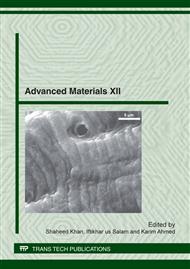p.321
p.330
p.335
p.343
p.348
p.356
p.364
p.371
p.378
Effect of Sintering Temperature on Nanostructured Multiferroic BiFeO3 Ceramics
Abstract:
Nanostructured multiferroic BiFeO3 (BFO) powders were synthesized by using the co-precipitation method. Calcination of acquired powder was carried out at 400°C for 3h. Uniaxially pressed pellets were sintered at 500°C, 600°C, 700°C and 800°C for 2 hours in air. These samples were characterized for structural, thermal, electrical and magnetic properties. X-ray diffraction (XRD) confirmed the amorphous nature of the as driven powder and phase purity of the calcined BFO sample. The crystallite size varied with the sintering temperature from 52 to 70 nm. Sintering above 500°C induced impure phases due to oxygen vacancies and volumetric strain in crystal structure. Ferroelectric to paraelectric transition temperature TC~815°C was verified by the differential scanning calorimetry (DSC). Surface morphology and grain growth was observed using scanning electron microscopy (SEM). Electrical ac measurements were performed in the frequency range from 20 Hz to 3 MHz at room temperature. For a particular sample, capacitance decreased and susceptance increased with the increase of applied frequency signal. These parameters were increased with the increase of sintering temperature. Vibrating sample magnetometer (VSM) revealed the diverse weak ferromagnetic behavior for the samples sintered at different temperatures. Maximum coercivity (Hc~119.2 Oe) and maximum remnant magnetization (MR~2.1x10-3 emu/g) were obtained for the sample sintered at 700°C for 2hr.
Info:
Periodical:
Pages:
348-355
Citation:
Online since:
May 2012
Authors:
Keywords:
Price:
Сopyright:
© 2012 Trans Tech Publications Ltd. All Rights Reserved
Share:
Citation:


